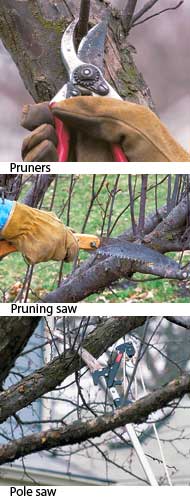tree pruning tools
Whether you’re new to tree pruning or have been doing it for years, you’ll find that one of the best times to start is when plants are dormant in winter or early spring. You can see the branches that need to be removed without all of those leaves in the way. And it’s good for the tree, too: The rising sap in spring will stimulate new growth to make the wounds heal over faster.
With a couple of exceptions, you can prune almost any deciduous tree this time of year. Maples and birches bleed sap if their bark is injured in the spring. Losing sap won’t kill the tree, but it is messy as it runs down the trunk or drips from branches. It’s better to wait until midsummer to prune these two trees.
Here are a few problems to watch for: Water sprouts are shoots that grow strictly upright from along the main branches. Stubs are blunt-ended branches left on the tree that detract from its natural or graceful shape. Crossed or rubbing branches create opportunities for disease or pests to enter. And finally, high up in the tree, too many small branches block sunlight, so the tree might need a little thinning. Once you’ve spotted some of these problems in your tree, the next step is to gather the right pruning tools.

These Felco pruners are our favorite — buy our Pruning Gift Set, which includes a #2 or #6 pair of Felco pruners, a sheath and The Pruner’s Bible, and we’ll throw in a free sharpener.
PRUNING SAW — If you’re removing branches smaller than 3 in. in diameter, a pruning saw works fine. The curved blade allows you to get into tight places. Or try a double-edged pruning saw. One edge has coarse teeth for rough cutting and the other has smaller teeth for making finer finish cuts.
POLE SAW — With this tool, you won’t need to climb into the tree or drag a ladder out of the shed to reach branches 15 ft. up. This pole saw has a curved blade so you can hook onto and easily cut a 2-in.-diameter branch. On the opposite side of the saw is a hook with a lopper blade that cuts when you pull on a rope. It comes in handy when you’re snipping small branches or twigs as you thin the crown.
















